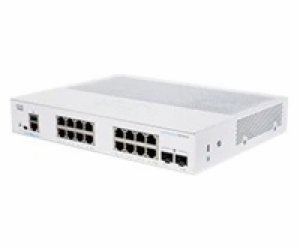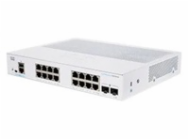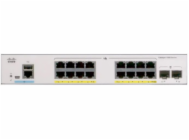Kategorie
Zpět k nákupu
Cisco switch CBS250-16T-2G (16xGbE,2xSFP,fanless) - REFRESH
3755 Kč
3103 Kč bez DPH
Dostupnost: Skladem v eshopu
Part no.: CBS250-16T-2GEU-RF
Kód produktu: 97123064
Výrobce: CISCO
 |
Potřebujete více informací?
484800850 po-pá 8:00-16:30 |
Popis produktu
CISCO REFRESH jsou repasované produkty, které společnost CISCO dodává s certifikací kvality, zárukou a servisní podporou odpovídající ekvivalentnímu novému produktu
Řada Cisco Business 250 představuje novou generaci cenově dostupných inteligentních switchů, které kombinují vysoký síťový výkon, zabezpečení a spolehlivost s komplexní sadou síťových funkcí potřebných pro spolehlivou síť malých firem.
Záruka platná do End of Support 31. 10. 2029.
Oznámení End of Life pro CISCO CBS250
Stránky produktu: CBS250-16T-2G
Quick start guide: Quick start guide
Switching capacity (All switches are wire-speed and nonblocking) Forwarding rate in millions of packets per second (mpps; 64-byte packets) 26,78
Switching capacity in Gigabits per second (Gbps) 36
Layer 2 switching Spanning Tree Protocol (STP) Standard 802.1d spanning tree support
Fast convergence using 802.1w (Rapid Spanning Tree Protocol [RSTP]), enabled by default
Multiple spanning tree instances using 802.1s (MSTP); 8 instances are supported
Per-VLAN Spanning Tree Plus (PVST+); 126 instances are supported
Rapid PVST+ (RPVST+); 126 instances are supported
Port grouping/link aggregation Support for IEEE 802.3ad Link Aggregation Control Protocol (LACP)
Up to 4 groups
Up to 8 ports per group with 16 candidate ports for each (dynamic) 802.3ad Link Aggregation Group (LAG)
VLAN Support for up to 255 active VLANs simultaneously
Port-based and 802.1Q tag-based VLANs
Management VLAN
Guest VLAN
Voice VLAN Voice traffic is automatically assigned to a voice-specific VLAN and treated with appropriate levels of QoS. Voice Services Discovery Protocol (VSDP) delivers networkwide zero-touch deployment of voice endpoints and call control devices
Generic VLAN Registration Protocol (GVRP) and Generic Attribute Registration Protocol (GARP) Protocols for automatically propagating and configuring VLANs in a bridged domain
IGMP (versions 1, 2, and 3) snooping Internet Group Management Protocol (IGMP) limits bandwidth-intensive multicast traffic to only the requesters; supports 255 multicast groups (source-specific multicasting is also supported)
IGMP querier Used to support a Layer 2 multicast domain of snooping switches in the absence of a multicast router
HOL blocking Head-of-Line (HOL) blocking prevention
Loopback detection Provides protection against loops by transmitting loop protocol packets out of ports on which loop protection has been enabled. It operates independently of STP.
Layer 3 routing IPv4 routing Wire-speed routing of IPv4 packets
Up to 32 static routes and up to 16 IP interfaces
IPv6 routing Wire-speed routing of IPv6 packets
Layer 3 interface Configuration of Layer 3 interface on physical port, LAG, VLAN interface, or loopback interface
Classless Interdomain Routing (CIDR) Support for CIDR
Dynamic Host Configuration Protocol (DHCP) relay at Layer 3 Relay of DHCP traffic across IP domains
User Datagram Protocol (UDP) relay Relay of broadcast information across Layer 3 domains for application discovery or relaying of Bootstrap Protocol (BootP)/DHCP packets
Security Secure Sockets Layer (SSL) SSL encrypts all HTTPS traffic, allowing secure access to the browser-based management GUI in the switch
Secure Shell (SSH) Protocol SSH is a secure replacement for Telnet traffic. Secure Copy (SCP) also uses SSH. SSH v1 and v2 are supported.
IEEE 802.1X (authenticator role) Remote Authentication Dial-In User Service (RADIUS) authentication, guest VLAN, single/multiple host mode, and single/multiple sessions
STP loopback guard Provides additional protection against Layer 2 forwarding loops (STP loops)
Secure Core Technology (SCT) Ensures that the switch will receive and process management and protocol traffic no matter how much traffic is received
Secure Sensitive Data (SSD) A mechanism to manage sensitive data (such as passwords, keys, and so on) securely on the switch, populating this data to other devices, and secure autoconfig. Access to view the sensitive data as plain text or encrypted is provided according to the user-configured access level and the access method of the user
Trustworthy systems Trustworthy systems provide a highly secure foundation for Cisco products
Run-time defenses (Executable Space Protection [X-Space], Address Space Layout Randomization [ASLR], Built-In Object Size Checking [BOSC])
Port security Ability to lock source MAC addresses to ports and limit the number of learned MAC addresses
RADIUS Supports RADIUS authentication for management access. Switch functions as a client.
Storm control Broadcast, multicast, and unknown unicast
DoS prevention Denial-of-Service (DoS) attack prevention
Multiple user privilege levels in CLI Level 1, 7, and 15 privilege levels
Access Control Lists (ACLs) Support for up to 512 rules
Drop or rate limit based on source and destination MAC, VLAN ID or IPv4 or IPv6 address, IPv6 flow label, protocol, port, Differentiated Services Code Point (DSCP)/IP precedence, TCP/UDP source and destination ports, 802.1p priority, Ethernet type, Internet Control Message Protocol (ICMP) packets, IGMP packets, TCP flag; ACL can be applied on both ingress and egress sides
Time-based ACLs supported
QoS Priority levels 8 hardware queues
Scheduling Strict priority and Weighted Round-Robin (WRR) queue assignment based on DSCP and class of service (802.1p/CoS)
Class of service Port based; 802.1p VLAN priority based; IPv4/v6 IP precedence/Type of Service (ToS)/DSCP based; Differentiated Services (DiffServ); classification and re-marking ACLs, trusted QoS
Rate limiting Ingress policer; egress shaping and rate control; per VLAN, per port, and flow based
Congestion avoidance A TCP congestion avoidance algorithm is required to reduce and prevent global TCP loss synchronization
Standards Standards IEEE 802.3 10BASE-T Ethernet, IEEE 802.3u 100BASE-TX Fast Ethernet, IEEE 802.3ab 1000BASE-T Gigabit Ethernet, IEEE 802.3ad Link Aggregation Control Protocol, IEEE 802.3z Gigabit Ethernet, IEEE 802.3x Flow Control, IEEE 802.3 ad LACP, IEEE 802.1D (STP), IEEE 802.1Q/p VLAN, IEEE 802.1w RSTP, IEEE 802.1s Multiple STP, IEEE 802.1X Port Access Authentication, IEEE 802.3af, IEEE 802.3at, RFC 768, RFC 783, RFC 791, RFC 792, RFC 793, RFC 813, RFC 879, RFC 896, RFC 826, RFC 854, RFC 855, RFC 856, RFC 858, RFC 894, RFC 919, RFC 920, RFC 922, RFC 950, RFC 951, RFC 1042, RFC 1071, RFC 1123, RFC 1141, RFC 1155, RFC 1157, RFC 1213, RFC 1215, RFC 1286, RFC 1350, RFC 1442, RFC 1451, RFC 1493, RFC 1533, RFC 1541, RFC 1542, RFC 1573, RFC 1624, RFC 1643, RFC 1700, RFC 1757, RFC 1867, RFC 1907, RFC 2011, RFC 2012, RFC 2013, RFC 2030, RFC 2131, RFC 2132, RFC 2233, RFC 2576, RFC 2616, RFC 2618, RFC 2665, RFC 2666, RFC 2674, RFC 2737, RFC 2819, RFC 2863, RFC 3164, RFC 3411, RFC 3412, RFC 3413, RFC 3414, RFC 3415, RFC 3416, RFC 4330
IPv6 IPv6 IPv6 host mode
IPv6 over Ethernet
IPv6/IPv4 Dual Stack
IPv6 Neighbor Discovery (ND)
IPv6 stateless address auto configuration
Path Maximum Transmission Unit (MTU) discovery
Duplicate Address Detection (DAD)
Internet Control Message Protocol (ICMP) version 6
IPv6 over IPv4 network with Intrasite Automatic Tunnel Addressing Protocol (ISATAP) support
USGv6 and IPv6 Gold Logo certified
IPv6 QoS Prioritize IPv6 packets in hardware
IPv6 ACL Drop or rate limit IPv6 packets in hardware
Multicast Listener Discovery (MLD v1/2) snooping Deliver IPv6 multicast packets only to the required receivers
IPv6 applications Web/SSL, Telnet server/SSH, Ping, Traceroute, Simple Network Time Protocol (SNTP), Trivial File Transfer Protocol (TFTP), Simple Network Management Protocol (SNMP), Remote Authentication Dia
Popis produktu
Cisco switch CBS250-16T-2G - REFRESHCISCO REFRESH jsou repasované produkty, které společnost CISCO dodává s certifikací kvality, zárukou a servisní podporou odpovídající ekvivalentnímu novému produktu
Řada Cisco Business 250 představuje novou generaci cenově dostupných inteligentních switchů, které kombinují vysoký síťový výkon, zabezpečení a spolehlivost s komplexní sadou síťových funkcí potřebných pro spolehlivou síť malých firem.
Záruka platná do End of Support 31. 10. 2029.
Oznámení End of Life pro CISCO CBS250
Stránky produktu: CBS250-16T-2G
Quick start guide: Quick start guide
Switching capacity (All switches are wire-speed and nonblocking) Forwarding rate in millions of packets per second (mpps; 64-byte packets) 26,78
Switching capacity in Gigabits per second (Gbps) 36
Layer 2 switching Spanning Tree Protocol (STP) Standard 802.1d spanning tree support
Fast convergence using 802.1w (Rapid Spanning Tree Protocol [RSTP]), enabled by default
Multiple spanning tree instances using 802.1s (MSTP); 8 instances are supported
Per-VLAN Spanning Tree Plus (PVST+); 126 instances are supported
Rapid PVST+ (RPVST+); 126 instances are supported
Port grouping/link aggregation Support for IEEE 802.3ad Link Aggregation Control Protocol (LACP)
Up to 4 groups
Up to 8 ports per group with 16 candidate ports for each (dynamic) 802.3ad Link Aggregation Group (LAG)
VLAN Support for up to 255 active VLANs simultaneously
Port-based and 802.1Q tag-based VLANs
Management VLAN
Guest VLAN
Voice VLAN Voice traffic is automatically assigned to a voice-specific VLAN and treated with appropriate levels of QoS. Voice Services Discovery Protocol (VSDP) delivers networkwide zero-touch deployment of voice endpoints and call control devices
Generic VLAN Registration Protocol (GVRP) and Generic Attribute Registration Protocol (GARP) Protocols for automatically propagating and configuring VLANs in a bridged domain
IGMP (versions 1, 2, and 3) snooping Internet Group Management Protocol (IGMP) limits bandwidth-intensive multicast traffic to only the requesters; supports 255 multicast groups (source-specific multicasting is also supported)
IGMP querier Used to support a Layer 2 multicast domain of snooping switches in the absence of a multicast router
HOL blocking Head-of-Line (HOL) blocking prevention
Loopback detection Provides protection against loops by transmitting loop protocol packets out of ports on which loop protection has been enabled. It operates independently of STP.
Layer 3 routing IPv4 routing Wire-speed routing of IPv4 packets
Up to 32 static routes and up to 16 IP interfaces
IPv6 routing Wire-speed routing of IPv6 packets
Layer 3 interface Configuration of Layer 3 interface on physical port, LAG, VLAN interface, or loopback interface
Classless Interdomain Routing (CIDR) Support for CIDR
Dynamic Host Configuration Protocol (DHCP) relay at Layer 3 Relay of DHCP traffic across IP domains
User Datagram Protocol (UDP) relay Relay of broadcast information across Layer 3 domains for application discovery or relaying of Bootstrap Protocol (BootP)/DHCP packets
Security Secure Sockets Layer (SSL) SSL encrypts all HTTPS traffic, allowing secure access to the browser-based management GUI in the switch
Secure Shell (SSH) Protocol SSH is a secure replacement for Telnet traffic. Secure Copy (SCP) also uses SSH. SSH v1 and v2 are supported.
IEEE 802.1X (authenticator role) Remote Authentication Dial-In User Service (RADIUS) authentication, guest VLAN, single/multiple host mode, and single/multiple sessions
STP loopback guard Provides additional protection against Layer 2 forwarding loops (STP loops)
Secure Core Technology (SCT) Ensures that the switch will receive and process management and protocol traffic no matter how much traffic is received
Secure Sensitive Data (SSD) A mechanism to manage sensitive data (such as passwords, keys, and so on) securely on the switch, populating this data to other devices, and secure autoconfig. Access to view the sensitive data as plain text or encrypted is provided according to the user-configured access level and the access method of the user
Trustworthy systems Trustworthy systems provide a highly secure foundation for Cisco products
Run-time defenses (Executable Space Protection [X-Space], Address Space Layout Randomization [ASLR], Built-In Object Size Checking [BOSC])
Port security Ability to lock source MAC addresses to ports and limit the number of learned MAC addresses
RADIUS Supports RADIUS authentication for management access. Switch functions as a client.
Storm control Broadcast, multicast, and unknown unicast
DoS prevention Denial-of-Service (DoS) attack prevention
Multiple user privilege levels in CLI Level 1, 7, and 15 privilege levels
Access Control Lists (ACLs) Support for up to 512 rules
Drop or rate limit based on source and destination MAC, VLAN ID or IPv4 or IPv6 address, IPv6 flow label, protocol, port, Differentiated Services Code Point (DSCP)/IP precedence, TCP/UDP source and destination ports, 802.1p priority, Ethernet type, Internet Control Message Protocol (ICMP) packets, IGMP packets, TCP flag; ACL can be applied on both ingress and egress sides
Time-based ACLs supported
QoS Priority levels 8 hardware queues
Scheduling Strict priority and Weighted Round-Robin (WRR) queue assignment based on DSCP and class of service (802.1p/CoS)
Class of service Port based; 802.1p VLAN priority based; IPv4/v6 IP precedence/Type of Service (ToS)/DSCP based; Differentiated Services (DiffServ); classification and re-marking ACLs, trusted QoS
Rate limiting Ingress policer; egress shaping and rate control; per VLAN, per port, and flow based
Congestion avoidance A TCP congestion avoidance algorithm is required to reduce and prevent global TCP loss synchronization
Standards Standards IEEE 802.3 10BASE-T Ethernet, IEEE 802.3u 100BASE-TX Fast Ethernet, IEEE 802.3ab 1000BASE-T Gigabit Ethernet, IEEE 802.3ad Link Aggregation Control Protocol, IEEE 802.3z Gigabit Ethernet, IEEE 802.3x Flow Control, IEEE 802.3 ad LACP, IEEE 802.1D (STP), IEEE 802.1Q/p VLAN, IEEE 802.1w RSTP, IEEE 802.1s Multiple STP, IEEE 802.1X Port Access Authentication, IEEE 802.3af, IEEE 802.3at, RFC 768, RFC 783, RFC 791, RFC 792, RFC 793, RFC 813, RFC 879, RFC 896, RFC 826, RFC 854, RFC 855, RFC 856, RFC 858, RFC 894, RFC 919, RFC 920, RFC 922, RFC 950, RFC 951, RFC 1042, RFC 1071, RFC 1123, RFC 1141, RFC 1155, RFC 1157, RFC 1213, RFC 1215, RFC 1286, RFC 1350, RFC 1442, RFC 1451, RFC 1493, RFC 1533, RFC 1541, RFC 1542, RFC 1573, RFC 1624, RFC 1643, RFC 1700, RFC 1757, RFC 1867, RFC 1907, RFC 2011, RFC 2012, RFC 2013, RFC 2030, RFC 2131, RFC 2132, RFC 2233, RFC 2576, RFC 2616, RFC 2618, RFC 2665, RFC 2666, RFC 2674, RFC 2737, RFC 2819, RFC 2863, RFC 3164, RFC 3411, RFC 3412, RFC 3413, RFC 3414, RFC 3415, RFC 3416, RFC 4330
IPv6 IPv6 IPv6 host mode
IPv6 over Ethernet
IPv6/IPv4 Dual Stack
IPv6 Neighbor Discovery (ND)
IPv6 stateless address auto configuration
Path Maximum Transmission Unit (MTU) discovery
Duplicate Address Detection (DAD)
Internet Control Message Protocol (ICMP) version 6
IPv6 over IPv4 network with Intrasite Automatic Tunnel Addressing Protocol (ISATAP) support
USGv6 and IPv6 Gold Logo certified
IPv6 QoS Prioritize IPv6 packets in hardware
IPv6 ACL Drop or rate limit IPv6 packets in hardware
Multicast Listener Discovery (MLD v1/2) snooping Deliver IPv6 multicast packets only to the required receivers
IPv6 applications Web/SSL, Telnet server/SSH, Ping, Traceroute, Simple Network Time Protocol (SNTP), Trivial File Transfer Protocol (TFTP), Simple Network Management Protocol (SNMP), Remote Authentication Dia
Přes veškerou snahu zajistit co nejpřesnější popis, obrázky a technické parametry produktů nemůžeme zaručit, že uváděná data odpovídají skutečnosti. Řada výrobců si vyhrazuje právo změny některých parametrů či vlastností bez předchozího upozornění. Potřebujete-li ujištění o určitých parametrech produktu nebo v případě pochybností, kontaktujte prosím svého obchodníka. Pozdější reklamace vlastností je zbytečnou komplikací pro obě strany.





















